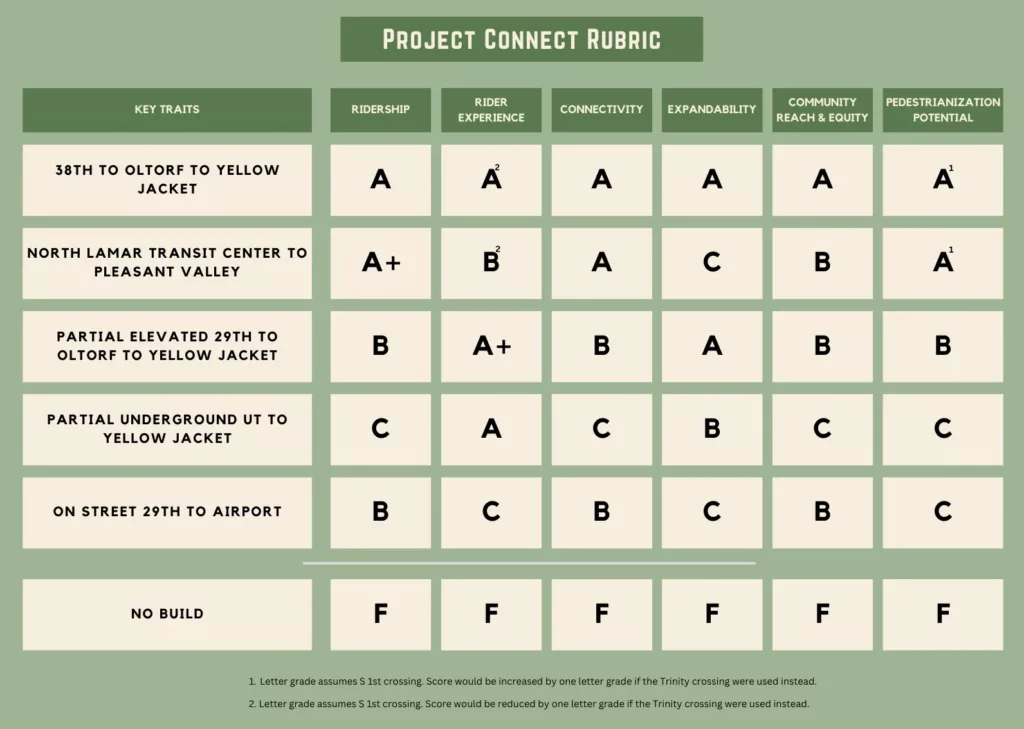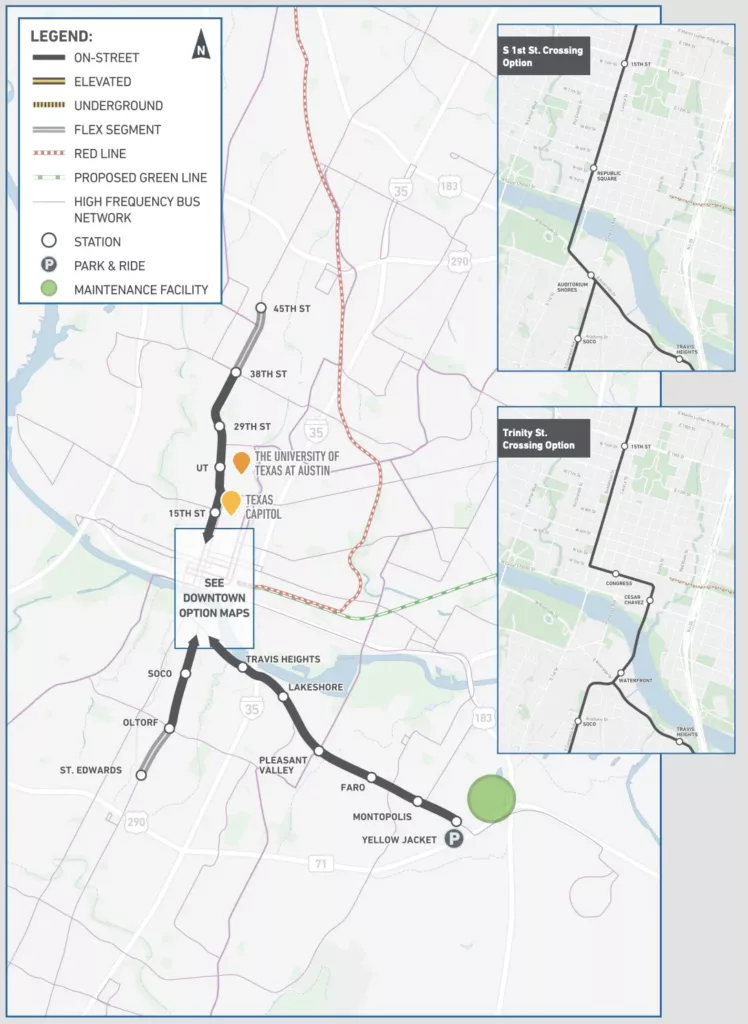The AURA Project Connect Working Group has diligently built an evaluation framework over the past few weeks to analyze all light rail options and the future of transit in Austin. Our goal was to equip Austinites with the necessary information to understand and contextualize each option’s impact on the city. Additionally, we aimed to provide a formal recommendation to inform the AURA membership’s endorsement vote. After extensive research, investigation, and evaluation, the AURA Project Connect Working Group has confidently settled on a recommendation: On-Street 38th to Oltorf to Yellow Jacket. AURA members will consider this recommendation and vote on which option to endorse as an organization.
While all options are undoubtedly better than the current lack of any light rail, the working group has recommended the 38th to Oltorf to Yellow Jacket option because it lays the best foundation for the city overall. It balances every key criterion while providing a foundation that enables us to quickly and iteratively expand the system, achieve our mode shift goals, and connect every part of Austin. Although the lack of grade separation and connections to valuable destinations such as the airport are valid concerns, we believe that these issues can be mitigated or resolved while retaining the strengths of this initial build option.
Before delving further, we want to express our appreciation for ATP’s leadership and engineers for their availability and helpfulness throughout the public input process. Throughout our internal process, ATP provided invaluable information and answered every question we had. This was crucial for the Project Connect Working Group to conduct a comprehensive and holistic evaluation of each option from every key angle. We are excited to collaborate with ATP, City Council, and CapMetro to make Project Connect a massive success.
How Did Each Option Do?
The following infographic presents the grades that each of the proposed light rail options received based on the rubric developed by the Project Connect Working Group. The evaluated options are On-Street 38th to Oltorf to Yellow Jacket, North Lamar Transit Center to Pleasant Valley, Partial Elevated 29th to Oltorf to Yellow Jacket, Partial Underground UT to Yellow Jacket and On-Street 29th to Airport.

While there is significant variability among all the options, each one holds immense potential for Austin’s future as a transit-oriented and sustainable city. The only alternative that receives a failing grade in this assessment is not building anything at all.
Our Reports & Evaluation of Each Option
On-Street 38th to Oltorf to Yellow Jacket
The proposed On-Street 38th to Oltorf to Yellow Jacket rail option is a light rail system that would run through the Guadalupe, East Riverside, and South Congress corridors, connecting major population centers and destinations in Downtown Austin. This option has the potential to significantly improve Austin’s transit infrastructure, with an estimated daily ridership of 30,000 and frequent service. Compared to other non-forked options, this option has double the frequency, which can increase ridership and add value to any potential expansion of the system to the north.
While the rider experience is generally positive with fast and convenient hop-on times, the at-grade operation may result in interruptions and reliability issues. Nonetheless, the route provides excellent connectivity, including access to grocery stores, the University of Texas, and a short bus connection to St. Edward’s University. Furthermore, the rail line is expandable from all ends and covers significant parts of Downtown Austin and the University of Texas. While concerns about grade separation and coverage in certain northern neighborhoods exist, the long-term benefits in terms of ridership, rider experience, expandability, community reach, equity, and pedestrianization potential led us to select this option as our recommendation.
We are currently working on a full list of implementation and policy recommendations that will address any downsides of the system to ensure its success. Some of these recommendations will be applicable to all options, but others may be specific to the On-Street 38th to Oltorf to Yellow Jacket rail option.
Partial Elevated 29th to Oltorf to Yellow Jacket
This option connects Guadalupe, East Riverside, and South Congress corridors, branching out to major destinations like Downtown Austin and the University of Texas. The system offers great connectivity, expandability, and the best rider experience out of all options, with potential for future growth and development. However, due to the high estimated cost of investing in elevated grade separation, it has fewer stations and serves fewer affordable-income households compared to the longest surface options. The option provides decent community reach and equity but needs improvements in pedestrianization potential and ridership to become a comprehensive transit system for the city.
North Lamar Transit Center to Pleasant Valley
This option was incredibly promising as a vision for light rail as it offers high initial ridership figures and excellent connectivity, but is significantly constrained in terms of expandability and rider experience. While the route has excellent connectivity and pedestrianization potential, it faces challenges in rider experience, expandability, and community reach & equity due to limited frequency, expansion constraints, and gaps in serving certain neighborhoods.
Partial Underground UT to Yellow Jacket
This proposed option is a light rail system that is intended to serve the East Riverside and Guadalupe corridors in Austin. It offers the highest level of service to the most densely populated areas of the city, connecting Downtown, the Texas Capitol Complex, and the University of Texas with major parks located south of the river, as well as new developments and student housing along Riverside. However, it does not offer service to North or South Austin. High costs associated with underground grade separation in downtown result in fewer stations and cause the system to miss several dense jobs and population centers further north. Initially, this option is expected to serve 20,000 daily riders, which is the lowest ridership of all the presented alternatives. Although the grade separation significantly improves the rider experience, the system’s 10-minute frequencies hold it back from truly excelling.
On-Street 29th to Airport
As Austin has grown into a hub of business and tourism, hosting major conferences and events like SXSW and ACL, people from all over the world travel to the city regularly. The Project Connect Working Group took concerns about the lack of a direct airport connection seriously. However, we ultimately decided against prioritizing a direct airport connection in the initial build due to the negative impact it would have on ridership, rider experience, and connectivity. Instead, we believe that connecting the Yellow Jacket station to the airport via a shuttle or AirTrain, which is funded separately from Project Connect, is a better option. The initial build of Project Connect’s light rail will serve as the backbone of Austin’s future as a more transit-oriented and sustainable city, and prioritizing a direct airport connection would not align with this vision.
Conclusion
The AURA Project Connect Working Group has worked diligently to produce these findings and recommendations. We’re confident that On-Street 38th to Oltorf to Yellow Jacket will provide the best backbone to Austin’s future as a transit-oriented and sustainable city. Still, AURA’s endorsement ultimately belongs to its membership, and we’re looking forward to seeing what they vote for. The other evaluated options are still promising, and each holds great potential for Austin’s future as a transit-oriented and sustainable city. The only alternative that receives a failing grade in this assessment is not building anything at all.
Special thanks to Christian Tschoepe, Chloe Wilkinson, Edgar Handal, Hunter Holder, Jimmy Daly, Parker Welch, Luis Osta Lugo, Zach Faddis, and everyone else involved in helping make the vision of the Project Connect Working Group a reality.




